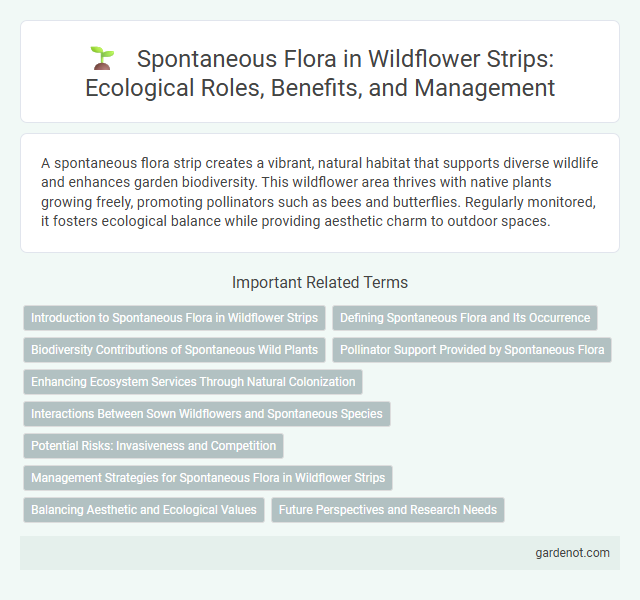A spontaneous flora strip creates a vibrant, natural habitat that supports diverse wildlife and enhances garden biodiversity. This wildflower area thrives with native plants growing freely, promoting pollinators such as bees and butterflies. Regularly monitored, it fosters ecological balance while providing aesthetic charm to outdoor spaces.
Introduction to Spontaneous Flora in Wildflower Strips
Spontaneous flora in wildflower strips comprises native and self-seeding plant species that naturally colonize without human intervention, enhancing biodiversity and ecosystem resilience. These plants improve soil health, provide habitat and food resources for pollinators, and contribute to ecological balance within agricultural landscapes. Understanding spontaneous flora dynamics is essential for optimizing wildflower strip design and promoting sustainable land management practices.
Defining Spontaneous Flora and Its Occurrence
Spontaneous flora refers to native or naturally occurring plant species that establish themselves without human intervention, thriving in wildflower strips through self-seeding and natural colonization processes. These plants contribute to biodiversity by creating dynamic habitats that support pollinators and other wildlife, enhancing ecosystem resilience. The occurrence of spontaneous flora in wildflower strips depends on factors such as soil type, local climate, and nearby seed sources, facilitating a diverse and sustainable plant community.
Biodiversity Contributions of Spontaneous Wild Plants
Spontaneous wild plants in wildflower strips significantly enhance biodiversity by providing essential habitat and food sources for pollinators, birds, and beneficial insects. Their natural adaptation to local conditions promotes ecological resilience and supports diverse microbial communities in the soil. This spontaneous flora contributes to ecosystem stability by fostering a balanced environment that sustains multiple trophic levels.
Pollinator Support Provided by Spontaneous Flora
Spontaneous flora strips offer vital habitats for diverse pollinator species such as bees, butterflies, and hoverflies, ensuring sustained biodiversity and ecosystem health. These natural plant assemblages provide continuous floral resources, including nectar and pollen, throughout the pollination season. Enhanced pollinator activity in spontaneous flora strips improves crop yields and supports local food webs by maintaining pollinator populations.
Enhancing Ecosystem Services Through Natural Colonization
A spontaneous flora strip leverages natural colonization to enhance ecosystem services by promoting biodiversity and providing habitat for pollinators and beneficial insects. This approach fosters soil health improvements through organic matter accumulation and supports natural pest control by encouraging predator populations. Over time, the self-sustaining plant community stabilizes, contributing to water retention and carbon sequestration in the local environment.
Interactions Between Sown Wildflowers and Spontaneous Species
Sown wildflowers in spontaneous flora strips create dynamic ecological interactions that enhance biodiversity and ecosystem resilience. These planted species provide essential resources, such as nectar and habitat, attracting pollinators that also support spontaneous native flora, promoting mutualistic relationships. Competition for nutrients and space occurs but often results in complementarity, where diverse species coexist and thrive, strengthening overall floral community health.
Potential Risks: Invasiveness and Competition
Spontaneous flora strips may present potential risks of invasiveness and competition, as aggressive species can dominate native plants, disrupting local biodiversity and ecosystem balance. Invasive flora often outcompetes wildflowers for resources such as light, water, and nutrients, leading to reduced plant diversity. Effective management requires monitoring species composition and implementing control measures to prevent the spread of invasive plants within wildflower strips.
Management Strategies for Spontaneous Flora in Wildflower Strips
Effective management strategies for spontaneous flora in wildflower strips involve selective mowing to prevent dominant species from outcompeting native wildflowers, promoting biodiversity. Integrating periodic monitoring allows for timely identification of invasive or aggressive species, facilitating targeted removal or control measures. Maintaining soil health through minimal disturbance supports natural regeneration and the establishment of a resilient spontaneous flora community within wildflower strips.
Balancing Aesthetic and Ecological Values
Spontaneous flora strips offer a dynamic blend of aesthetic charm and ecological benefits by supporting native biodiversity and natural habitats within urban or rural landscapes. These strips provide crucial pollinator resources and contribute to soil health while creating visually appealing, low-maintenance green corridors. Balancing plant species diversity and seasonal bloom patterns enhances both environmental value and the scenic quality of wildflower strips.
Future Perspectives and Research Needs
Research on spontaneous flora strips reveals their potential to enhance biodiversity and ecosystem services in agricultural landscapes. Future perspectives emphasize the need for long-term ecological monitoring, species composition optimization, and evaluation of pollinator interactions. Investigating adaptive management strategies and the effects of climate change on spontaneous wildflower communities remains a critical research priority.
Spontaneous flora strip Infographic

 gardenot.com
gardenot.com